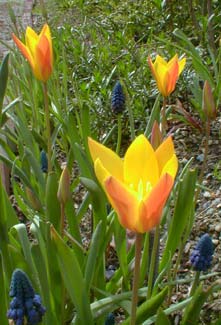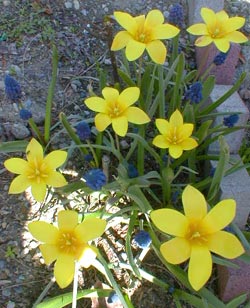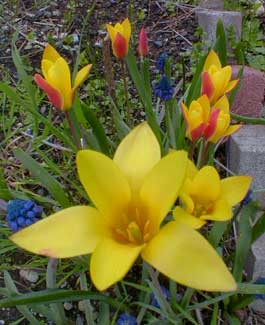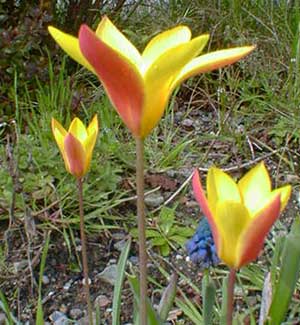
'Chrysantha' Lady Tulip
or Candlestick Tulip
"Like a tulip's flame I burn
In your presence as I turn;
By my life, & yours, I swear
Youth of Persia ever fair!"
-Allama Iqbal
(1877-1938)
(1877-1938)
 Tulipa clusiana var chrysantha is sometimes listed as its own speces, Tulipa chrysantha, & sometimes sold as though the cultivar name were 'Chrysantha.'
Tulipa clusiana var chrysantha is sometimes listed as its own speces, Tulipa chrysantha, & sometimes sold as though the cultivar name were 'Chrysantha.'It is very similar to T. clusiana 'Cynthia,' but where 'Cynthia' is ivory white & pink-red, 'Chrysantha' is yellow & orange-red.
'Chrysantha' is in full bloom a week or so sooner, & 'Cynthia' is still around when 'Chrysantha' is fading, so they make lovely companions to maximize the period of time when the lady tulips are present.
 These two strains are planted in such close proximity so that the two small drifts of lady tulips blend into a single drift with more impact. They do not hybridize because T. clusiana varieties cannot produce viable seed, but each grouping reproduces offsets to increase their numbers.
These two strains are planted in such close proximity so that the two small drifts of lady tulips blend into a single drift with more impact. They do not hybridize because T. clusiana varieties cannot produce viable seed, but each grouping reproduces offsets to increase their numbers.If after three or four years they seem to have grown "tired" & don't bloom, they should be lifted after the leaves begin to die back, the offsets removed, & replanted.
When fully open on strongly sunny days, the blooms form bright yellow stars (hence formerly called Tulipa stellata). The second April photo shows them on just such a sunny day, with the red outsides hidden beneath the flowers' outspread petals.
It doesn't take much of an overcast to keep them from opening all the way, but when they're partially closed they show more of the bicolor exterior petals, as in the first photo above & fourth photo below.
 This species variant is native of harsh regions of Uzbekistan, hence very hardy & easy to grow in the garden. It needs moist well drained soil while in spring growth, & hot well-sunned soil during summer dormancy. It grows eight to twelve inches tall. It can tolerate a bit of shade, but like most tulips will really do best in full sun.
This species variant is native of harsh regions of Uzbekistan, hence very hardy & easy to grow in the garden. It needs moist well drained soil while in spring growth, & hot well-sunned soil during summer dormancy. It grows eight to twelve inches tall. It can tolerate a bit of shade, but like most tulips will really do best in full sun.The bulbs like to be planted a full six inches deep, so it is possible to layer over them another bulb at a much shallower level. We planted only five 'Chrysantha' bulbs; & over them, at three inches depth, went a grape hyacinth look-alike Bellevalia pycnantha.
The Bellevalia is budding a mat-finish blue by mid-March, but the buds develop quite slowly. So by the time it is getting big & swollen & really looking like a grape hyacinth, that's exactly when the candlestick buds of 'Chrysantha' are opening up, at the very tail-end of March or in early April. It was blind good luck, but these flowers look tremendous together, with long-overlapping bloom times.